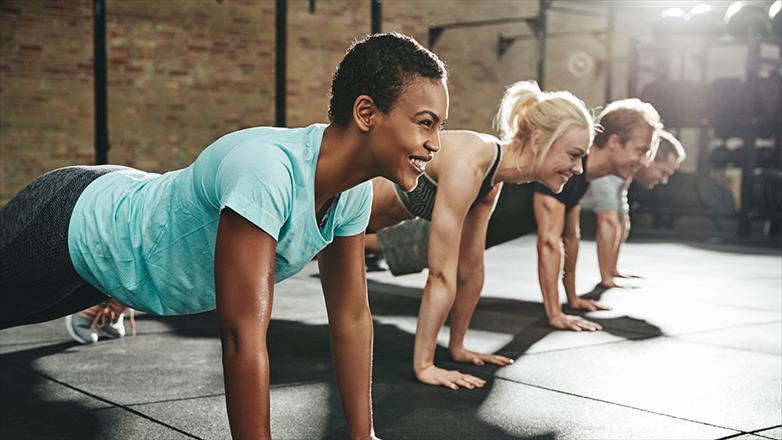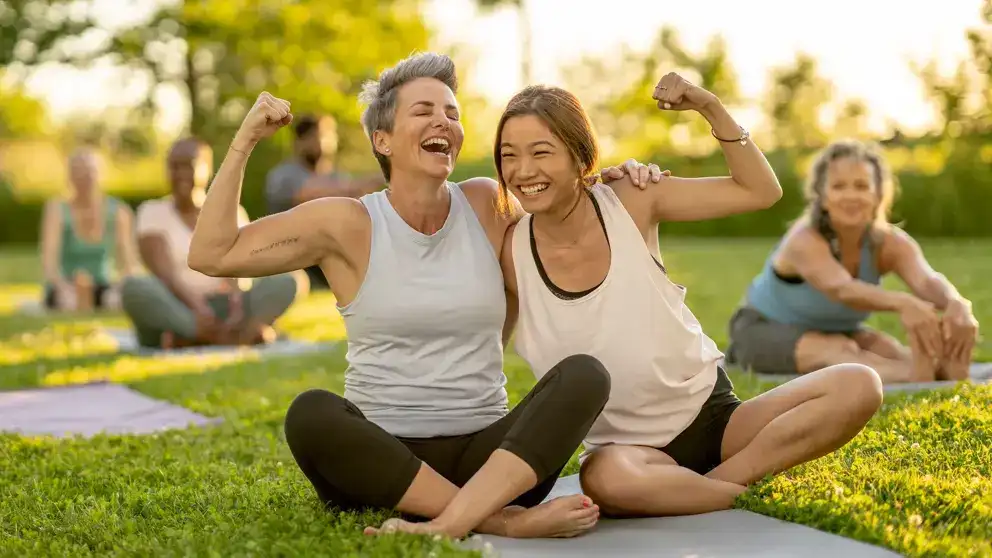Best Exercises for Happiness and Health
1. Cardiovascular Exercises
Cardiovascular exercises, also known as aerobic exercises, are essential for maintaining overall health and happiness. These exercises help improve cardiovascular health, increase lung capacity, and boost mood by releasing endorphins. Some popular cardiovascular exercises include running, cycling, swimming, and dancing.
By incorporating cardiovascular exercises into your routine, you can improve your heart health, reduce the risk of chronic diseases, and increase your overall sense of well-being. Aim for at least 150 minutes of moderate-intensity cardiovascular exercise per week to experience the full benefits.

In addition to physical health benefits, cardiovascular exercises have been shown to improve mental health by reducing symptoms of anxiety and depression. The release of endorphins during these exercises can help elevate mood and reduce stress levels, leading to a happier and healthier lifestyle.
2. Strength Training
Strength training exercises are crucial for building and maintaining muscle mass, improving bone density, and boosting metabolism. Incorporating strength training into your exercise routine can help you achieve a toned and strong physique while also improving your overall happiness and well-being.

Some popular strength training exercises include weightlifting, bodyweight exercises, and resistance band workouts. By increasing muscle mass, you can improve your overall strength and endurance, making everyday tasks easier and more enjoyable.
Strength training exercises have also been shown to improve mood and mental health by increasing levels of dopamine and serotonin in the brain. This can help reduce symptoms of depression and anxiety, leading to a happier and more fulfilling life.
3. Yoga

Yoga is a holistic practice that combines physical postures, breathing techniques, and meditation to promote overall health and well-being. Practicing yoga regularly can improve flexibility, strength, balance, and mental clarity, leading to a greater sense of happiness and inner peace.
There are many different styles of yoga to choose from, ranging from gentle and restorative practices to more vigorous and dynamic flows. Whether you prefer a slow and mindful practice or a fast-paced and challenging class, there is a style of yoga that can benefit both your physical and mental health.

In addition to improving physical fitness, yoga has been shown to reduce stress, anxiety, and symptoms of depression. By focusing on the breath and present moment during yoga practice, you can cultivate a sense of mindfulness and inner peace that can improve your overall happiness and well-being.
4. Pilates
Pilates is a low-impact exercise that focuses on core strength, flexibility, and alignment. By practicing Pilates regularly, you can improve your posture, balance, and overall body awareness, leading to a healthier and happier lifestyle.

Pilates exercises are designed to target specific muscle groups, with an emphasis on the core muscles that support the spine and pelvis. By strengthening these muscles, you can improve your stability and prevent injuries, allowing you to move with ease and confidence in your daily activities.
In addition to physical benefits, Pilates has been shown to improve mental health by promoting relaxation and reducing stress levels. The focus on breath and mindfulness during Pilates practice can help calm the mind and body, leading to a greater sense of happiness and well-being.
5. Mind-Body Exercises

Mind-body exercises, such as Tai Chi and Qigong, combine physical movement with mental focus and deep breathing to promote relaxation, balance, and overall well-being. These exercises can help reduce stress, improve flexibility, and cultivate a sense of inner peace and happiness.
Tai Chi is a gentle form of martial arts that involves slow, flowing movements and deep breathing to calm the mind and body. By practicing Tai Chi regularly, you can improve your balance, coordination, and overall sense of well-being.

Qigong is another mind-body exercise that focuses on cultivating and balancing the body’s energy, or qi. By practicing Qigong, you can improve your mental clarity, reduce stress, and promote a sense of inner harmony and happiness.
Incorporating mind-body exercises into your routine can help you achieve a greater sense of mindfulness, presence, and overall well-being. By connecting the mind and body through movement and breath, you can improve your physical and mental health, leading to a happier and more fulfilling life.
6. Outdoor Activities
Spending time outdoors and engaging in physical activities such as hiking, biking, or gardening can have a positive impact on both your physical and mental health. Outdoor activities can help reduce stress, improve mood, and increase feelings of happiness and well-being.
Being in nature has been shown to have a calming effect on the mind and body, reducing symptoms of anxiety and depression. By immersing yourself in natural surroundings, you can lower cortisol levels, reduce inflammation, and improve overall mental health.
In addition to the mental health benefits, outdoor activities can also improve physical fitness by engaging different muscle groups and promoting cardiovascular health. Whether you prefer a leisurely walk in the park or a challenging hike in the mountains, spending time outdoors can lead to a happier and healthier lifestyle.
7. Group Exercise Classes
Group exercise classes, such as spin, Zumba, or boot camp, offer a fun and social way to stay active and improve your fitness levels. By joining a group class, you can connect with others, stay motivated, and enjoy the benefits of a structured workout routine.
Group exercise classes provide a sense of community and support, helping you stay accountable and committed to your fitness goals. Whether you prefer high-energy cardio classes or relaxing yoga sessions, there is a group exercise class that can cater to your fitness preferences and goals.
In addition to the physical benefits, group exercise classes can also improve mental health by reducing feelings of isolation and loneliness. By working out with others and sharing a common goal, you can boost your mood, increase self-confidence, and experience a greater sense of happiness and well-being.
8. Dance Workouts
Dance workouts, such as Zumba, hip hop, or salsa, offer a fun and energetic way to stay active and improve your fitness levels. By dancing to your favorite music and learning new choreography, you can burn calories, tone muscles, and improve your coordination and balance.
Dance workouts are a great way to boost your mood and reduce stress levels by releasing endorphins and increasing serotonin levels in the brain. The rhythmic movements and music can help elevate your mood, improve your confidence, and promote a sense of happiness and well-being.
Incorporating dance workouts into your routine can help you stay motivated and excited about exercise, leading to a more consistent and enjoyable fitness routine. Whether you prefer Latin rhythms, hip hop beats, or ballroom elegance, there is a dance workout that can cater to your interests and fitness goals.
Conclusion
In conclusion, incorporating a variety of exercises into your routine can help improve your physical and mental health, leading to a greater sense of happiness and well-being. Cardiovascular exercises, strength training, yoga, Pilates, mind-body exercises, outdoor activities, group exercise classes, and dance workouts all offer unique benefits that can help you achieve a healthier and happier lifestyle.
By finding activities that you enjoy and that challenge you physically and mentally, you can stay motivated and committed to your fitness goals. Whether you prefer high-intensity workouts or gentle mind-body practices, there is an exercise routine that can cater to your preferences and help you achieve a greater sense of happiness and well-being.
Remember to listen to your body, stay hydrated, and nourish yourself with healthy foods to support your exercise routine. Prioritize self-care, rest, and recovery to prevent burnout and injuries, and always consult with a healthcare professional before starting a new exercise program.
By making exercise a priority in your life, you can improve your physical fitness, mental health, and overall well-being, leading to a happier and healthier lifestyle.
FAQ
Q: How often should I exercise to improve my happiness and health?
A: Aim for at least 150 minutes of moderate-intensity cardiovascular exercise per week, along with regular strength training sessions and mind-body exercises to achieve optimal physical and mental health benefits.
Q: What are the best exercises for reducing stress and anxiety?
A: Mind-body exercises, such as yoga, Tai Chi, and Qigong, are excellent for reducing stress and anxiety, promoting relaxation, and improving mental clarity and well-being.
Q: Can outdoor activities improve my mental health and happiness?
A: Yes, spending time outdoors and engaging in physical activities in nature can have a positive impact on mental health by reducing stress, improving mood, and promoting feelings of happiness and well-being.